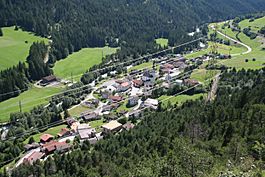Surava facts for kids
Quick facts for kids
Surava
|
||
|---|---|---|
 |
||
|
||
| Country | Switzerland | |
| Canton | Graubünden | |
| District | Albula | |
| Area | ||
| • Total | 7.0 km2 (2.7 sq mi) | |
| Elevation | 904 m (2,966 ft) | |
| Population
(Dec 2013)
|
||
| • Total | 196 | |
| • Density | 28.00/km2 (72.5/sq mi) | |
| Postal code |
7472
|
|
| Surrounded by | Alvaneu, Brienz/Brinzauls, Tiefencastel | |
Surava was once a small town, or municipality, in the beautiful mountains of Switzerland. It was located in the canton of Graubünden, in an area called Albula.
On January 1, 2015, Surava joined with several other nearby towns. These included Alvaschein, Mon, Stierva, Tiefencastel, Alvaneu, and Brienz/Brinzauls. Together, they formed a new, larger municipality named Albula/Alvra.
Contents
A Look at Surava's Past
Surava is an old place with a long history. It was first written about around the year 1580. Back then, it was known by a slightly different name, Surraguas.
Where is Surava Located?
Before it joined the new municipality, Surava covered an area of about 7 square kilometers (2.7 square miles). Imagine a square about 2.6 kilometers (1.6 miles) on each side – that was roughly the size of Surava!
A small part of this land, about 10%, was used for farming. A much larger part, nearly 80%, was covered by forests. About 4% of the land had buildings and roads, while the rest was made up of rivers, mountains, or other natural areas.
Surava is a type of settlement called a linear village. This means it stretches out in a line, usually along a road or a river. Surava is located on the right side of the Albula River. In 1883, the municipality of Brienz-Surava split into two separate towns: Brienz/Brinzauls and Surava.
Who Lives in Surava?
In 2013, Surava had a population of 196 people. About 7% of the people living there in 2008 were from other countries. Over the ten years before 2013, the number of people living in Surava went down by about 22%.
In the year 2000, there were slightly more males (52.8%) than females (47.2%) living in Surava.
Here's a quick look at the population changes over time:
| year | population |
|---|---|
| 1725 | 89 |
| 1850 | 159 |
| 1900 | 148 |
| 1950 | 203 |
| 1960 | 136 |
| 1970 | 93 |
| 1980 | 62 |
| 1990 | 73 |
| 2000 | 150 |
Education and Jobs in Surava
Many adults in Surava (about 66%) have completed more than just basic schooling. This includes either upper secondary education (like high school) or even higher education, such as university.
Surava has a very low unemployment rate, meaning most people who want to work can find a job. In 2005, there were:
- 8 people working in the primary sector (like farming or forestry). There were 3 businesses in this area.
- 22 people working in the secondary sector (like manufacturing or construction). There were 7 businesses in this area.
- 35 people working in the tertiary sector (like services, shops, or tourism). There were 8 businesses in this area.
Languages Spoken in Surava
Most people in Surava speak German. In 2000, about 78% of the population spoke German. The second most common language was Romansh, spoken by about 11% of the people. Albanian was the third most common language, spoken by about 3%.
Here's how the languages spoken in Surava have changed over the years:
| Languages | Census 1980 | Census 1990 | Census 2000 | |||
|---|---|---|---|---|---|---|
| Number | Percent | Number | Percent | Number | Percent | |
| German | 116 | 60.42% | 161 | 76.67% | 196 | 78.40% |
| Romanish | 66 | 34.38% | 45 | 21.43% | 27 | 10.80% |
| Italian | 10 | 5.21% | 2 | 0.95% | 4 | 1.60% |
| Population | 192 | 100% | 210 | 100% | 250 | 100% |
See also
 In Spanish: Surava para niños
In Spanish: Surava para niños






